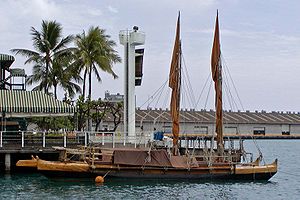This article has multiple issues. Please help improve it or discuss these issues on the talk page. (Learn how and when to remove these messages)
|
Hawaiʻiloa (alt. Hawaiʻi Loa or Ke Kowa i Hawaiʻi) is a mythical Hawaiian fisherman and navigator who is said to have discovered the island of Hawaiʻi.
Legend
| This section needs additional citations for verification. Please help improve this article by adding citations to reliable sources in this section. Unsourced material may be challenged and removed. (August 2021) (Learn how and when to remove this message) |
Hawaiʻiloa was an expert fisherman and navigator who was famous for his lengthy fishing expeditions. While on a prolonged voyage, his principal navigator, Makaliʻi, asked Hawaiʻiloa to steer eastward towards Aldebaran (Hokuʻula, meaning "red star") and the Pleiades (near the Cluster of Makaliʻi). After sailing in this direction, he and his crew stumbled upon the island of Hawaiʻi, which was named in Hawaiʻiloa's honor. Hawaiʻiloa returned to his homeland, Ka ʻāina kai melemele a Kāne ("the land of the yellow sea of Kāne"), to bring his family back with him to Hawaiʻi. He then organized a colonizing expedition with his family and eight other skilled navigators. They settled on what is now the Island of Hawaiʻi, named in his honor.
The legend contains reference to his children: Māui (his eldest son), Kauaʻi (son), and Oʻahu (daughter) who settled on the islands that bear their names.
Historical accuracy
The Hawaiʻiloa legend is popular amongst Hawaiians as a realistic Hawaiian origin story that is consistent with modern anthropological and historical beliefs.
However, there is currently little evidence to support its historical accuracy. The story is attested only by 19th-century sources such as Abraham Fornander and Thomas George Thrum, neither of whom provided their sources.
Hawaiʻiloa is also unmentioned by earlier Hawaiian historians such as David Malo. Malo chronicled many Hawaiian origin stories, migration tales, and legends of indigenous origin. Samuel Kamakau tells of an alternate legend that the first man (Kumu-Honua) and woman (Lalo-Honua) were created on Oʻahu.
Canoe

Hawaiʻiloa is also the name of a voyaging canoe, built between 1991 and 1994. Named after the legendary navigator, the canoe was built for ocean navigation and has sailed internationally. The canoe Hawaiʻiloa is now docked at Honolulu Harbor. It is often sailed on long voyages throughout the Pacific Ocean, studying voyaging techniques used in Ancient Hawaii.
Building
To make the canoe, two Sitka spruce logs were brought to Hawaiʻi from Southeast Alaska, donated by the SeAlaska Corporation (owned by the Tlingit, Haida, and Tshimshian tribes). These came from 400-year-old, 200 feet high trees, a size which could not be found in modern Hawaiʻi. The hulls of the canoe were designed by Rudy and Barry Choy and Dick Rhodes, and also used numerous woods from more local sources. The canoe was made without metal parts, and used three miles of lashing.
Hawaiʻiloa is 57 feet (17 m) long, with a beam of 19 feet (5.8 m). She has two sails, each of 240–420 square feet (22–39 m). She was initially launched in July 1993, and subsequently modified in dry dock before being re-launched a year later.
Voyages in 1995
In 1995, Hawaiʻiloa sailed her maiden voyage to Tahiti, Raʻiatea, and Nuku Hiva in the Marquesas Islands in company with Hōkūleʻa and a third canoe from Hawaiʻi called Makaliʻi together with two canoes from Rarotonga: Te ʻAu Tonga and Takitumu, and the canoe Te ʻAurere, from New Zealand. Subsequently that year, Hawaiʻiloa was shipped to Seattle and then sailed north to Alaska, visiting twenty native villages on the coastal journey between Vancouver and Juneau.
See also
References
- Samuel M. Kamakau and Z. Kepelino: Hawai‘iloa and the Discovery of Hawai‘i www2.hawaii.edu, accessed 25 September 2020
- "Origins of Hawaii's Names". Archived from the original on 2006-12-30. Retrieved 2007-02-24.
- ^ The Building of Hawai‘iloa archive.hokulea.com, accessed 2020-09-22
- ^ Nainoa Thompson: Recollections of the Building of Hawai‘iloa and the 1995 Voyages archive.hokulea.com, accessed 25 September 2020
- Nainoa Thompson - Biography www.ifa.hawaii.edu, accessed 25 September 2020
| Culture of indigenous Oceania | |||||||||||||
|---|---|---|---|---|---|---|---|---|---|---|---|---|---|
| List of resources about traditional arts and culture of Oceania | |||||||||||||
| Art | |||||||||||||
| Broad culture | |||||||||||||
| Geo-specific, general |
| ||||||||||||
| Canoes | |||||||||||||
| Dance | |||||||||||||
| Festivals | |||||||||||||
| Languages |
| ||||||||||||
| Literature |
| ||||||||||||
| Music |
| ||||||||||||
| Mythology | |||||||||||||
| Research | |||||||||||||
| People |
| ||||||||||||
| Religion |
| ||||||||||||
| For other topics including Oceanian cinema, indigenous currency, dress, folklore and cuisine, see Category:Culture of Oceania. | |||||||||||||




